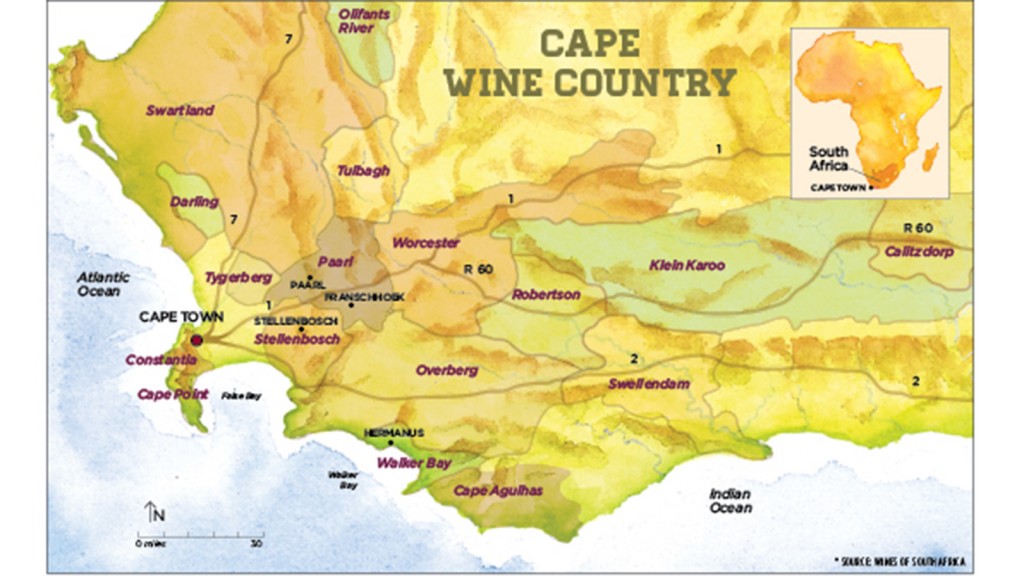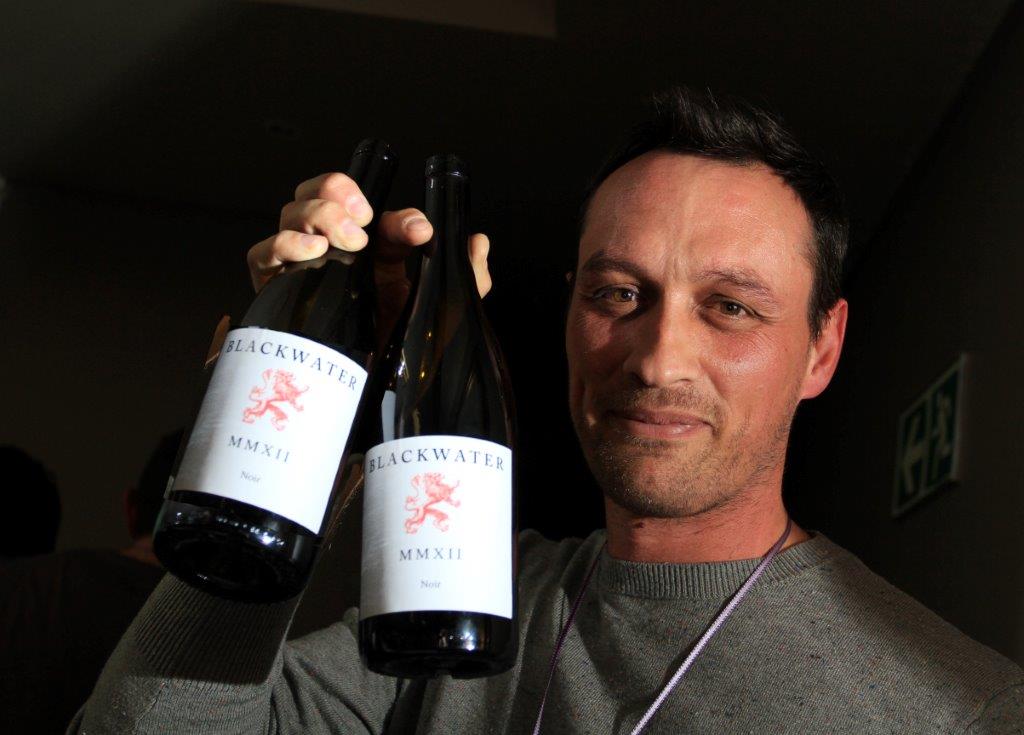
16 Nov How to make wine without water
South Africa is one of the world’s leading wine producers, 95% of it in the Western Cape. Yolandi Groenewald investigates the delicate tightrope wine farmers have to negotiate in adapting to a drier environment caused by climate change
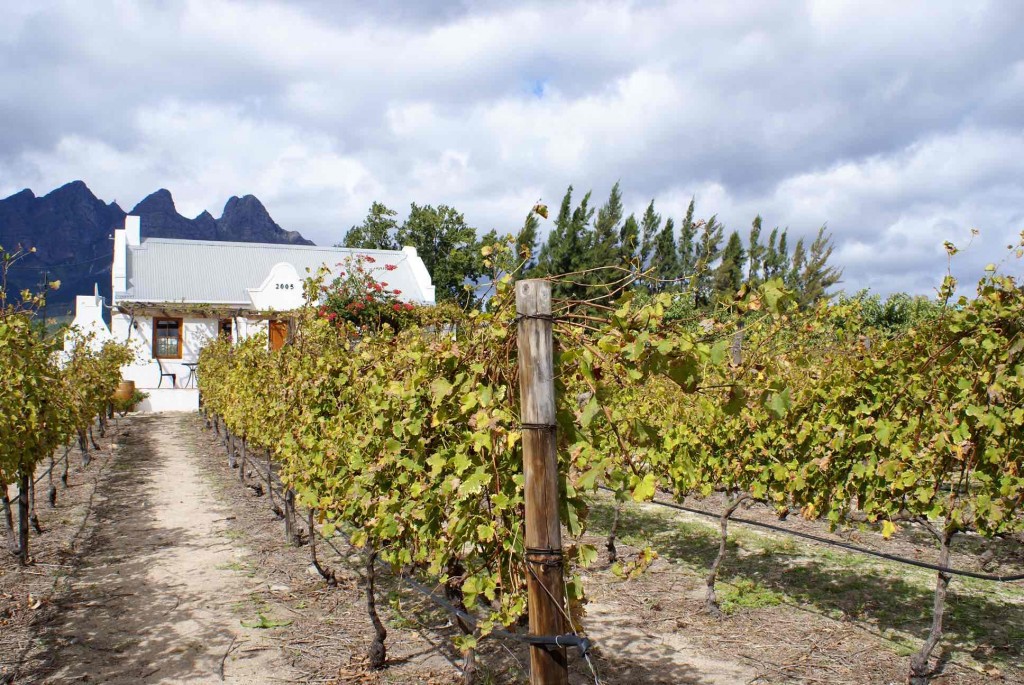
Bartinney wine farm on the slopes of Helshoogte has lessened its water footprint by getting rid of alien plant species. Photo: Yolandi Groenewald
For the past two years wine farmers in the Western Cape have felt the wrath of nature. High temperatures and little rain have pushed some farmers to the brink. Winter, traditionally the rainy season in the region, passed by with little rain falling on the parched vineyards and dams remained alarmingly empty.
Vineyards turned bone dry, and farmers had to irrigate extensively with the precious little water available to keep them from ruin. Some farmers couldn’t even harvest their grapes, and opted to take out the grapes to save their vineyards.
To cope with the changing conditions some farmers have given up irrigation and become super water-efficient, while other visionaries are turning to innovative grape varietals to leave a new legacy for South Africa’s famous wine industry.
“We are on the threshold of danger,” says Swartland master winemaker Eben Sadie.
Winemaker Rob Armstrong, from Haut Espoir wine estate in picture-perfect Franschhoek, frowns as he gazes over his vineyards.
“Climate change is a relatively large threat to us and our livelihoods,” he says. “This ranks very high up there. I’m fairly well clued up about what is coming, and equally scared.”
He says over the past 14 years of record keeping on the farm, the last two years have been the driest.
“Neighbours who have kept records for longer report that this period has been the driest in 50 years,” he says. “Heat has also been a big factor, there have been significantly hotter periods leading up to the harvest which affect quality and quantity.
“And then the corresponding cooler weather in winter, when we need cold periods, has not been as cold in the past three years over winter, and earlier bud burst and earlier harvests have been noted.”
Sadie says at the end of this year’s winter rainy season, the Swartland – where he farms – was 35% short of its annual rainfall.
“We haven’t even caught up to the realities of the big drought last year. We are in big trouble,” he sighs. “Many farmers around me will not survive another dry spell.”
Swartland winemaker Francois Haasbroek, from Blackwater Wines, says 2016 was so dry winemakers were worried about whether there would be any grapes at all.
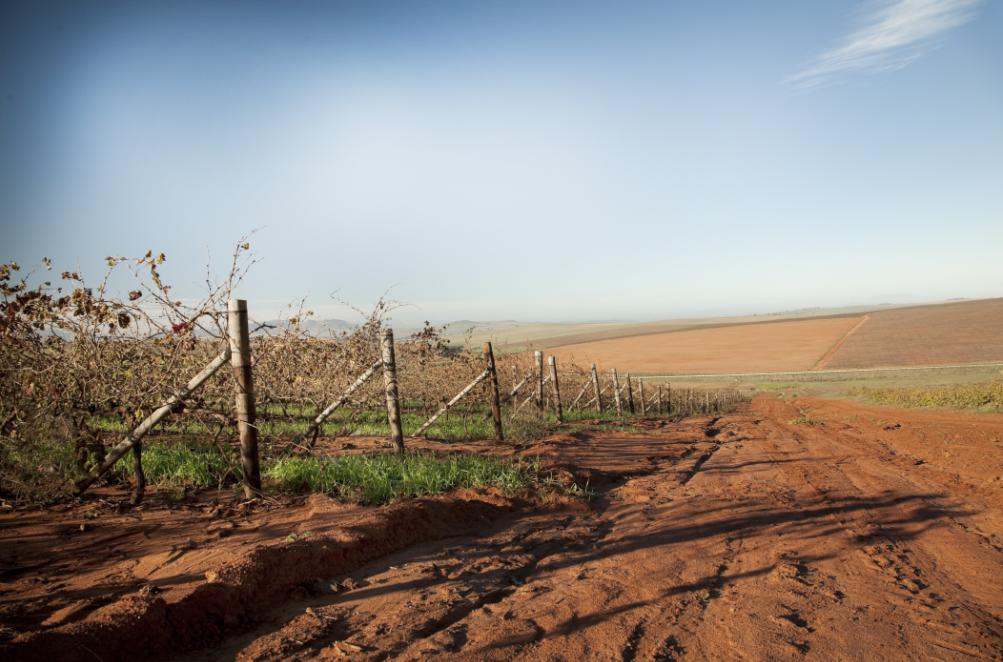
Winemakers in the Swartland say 2016 has been so dry they were worried about whether there would be any grapes at all
More drought is coming
Things aren’t looking up for the farmers, as climate models predict less and less rain in future for the region, endangering South Africa’s wine future. (See scientific data modelling for future scenarios in the region on the ClimaTracker app here.)
The most recent drought was prompted by El Niño, a recurring natural phenomenon triggered by warming surface temperatures in the equatorial Pacific Ocean. Scientists say El Niño occurs every two to seven years, but as oceans warm due to climate change El Niño is expected to intensify and so “load the dice” for the Western Cape wine farmers.
Water shortage is a crucial component of climate change’s effect on the Cape’s wine industry. Less rain and more droughts are likely to be accompanied by higher temperatures, scientific models predict. More heat waves can also be expected in summer, with hail and violent wind in winter.
Agriculture is one of the pillars of the Western Cape economy and viticulture plays a critical role in this sector, which remains one of South Africa’s leading agri-exporters.
South Africa is the eighth-largest national wine producer by volume worldwide. Last year the Western Cape contributed R36,1-billion to the economy, via agriculture, manufacturing, trade and hospitality, while generating direct and indirect employment for close to 300,000 people. Almost 95% of the country’s wine grapes are grown in the Cape winelands.
Adapt or die
Shelly Fuller, programme manager at WWF’s Fruit & Wine Initiatives in South Africa, says the need to stay relevant in a water-constrained future has forced farmers to reduce their water footprint.
“Irrigation techniques have changed dramatically for farmers as they adapt,” she says, adding that technological advances such as soil probes and moisture meters allow farmers to be more precise about how much water their vineyards need.
She says farmers have had to start irrigating earlier and longer to keep vineyards alive, while balancing against water scarcity.
“They definitely have to use less water, but at the right time,” she says.
The Biodiversity and Wine Initiative, a collaboration between the South African wine industry and the conservation sector, rewards environmental champions and encourages farmers to adopt eco-friendly practices
Joan Isham, the initiative’s senior extension officer, says all its champions have dramatically lessened their water usage.
“They are in tune with what their soil moisture is and that you don’t need to over-irrigate,” she says. But the champions are also improving their soil, which lessens their water usage even more.
“They have to do things better to survive. They don’t really have a choice,” Isham says. “Change is coming.”
Later harvests
Haut Espoir’s Armstrong says his family has been making wine since 2004, and has never picked grapes before the middle of February.
“Valentine’s Day is usually when we pick our first grapes,” he says “For 2014 and 2015 we picked in the second week of January. We pick earlier to avoid the resulting spike in sugars.”
He expects climate change to produce even drier years in future.
“This equates to significant drops in production, tonnage losses and overly sweet grapes without the resulting phenolic ripeness,” he says. “We’ll have to work the grapes harder in the cellar, and incur more input costs down the production lines. A worst-case scenario would be mortality in the vineyards, which would then hinder production even further.”
Haasbroek says 2016 has been an extremely “bumpy ride. Normally we get four and a half tonnes from our vineyards, this year it was only two. I was ecstatic to hear that we were harvesting at all. There were regions that didn’t harvest.”
Philip Jonker, a fourth-generation family winemaker at Weltevrede Estate, is watching the changing climate with bated breath. His family has been farming the land in Robertson since 1912 and has seen firsthand the sensitivity of nature where “a slight change in climate trigger a whole chain of things”.
Like Armstrong, he too has noticed harvests happening earlier. “If it remains dry as we are used to, we need to irrigate, but a dry cycle of consecutive years may dry up irrigation sources which we rely on,” he says.
He explains that vines need cold winters and moderate summers, and about 550mm to 650mm of water annually.
“If winters warm up, budding is not good and crop levels will drop,” he says. “If summers get too hot, flavours are lost.”
To water or not to water?
Exactly how farmers should adapt to climate change is open to debate.
In 2010 Armstrong changed to bio-dynamic farming, which he says has significantly helped the farm cope during the drought. He has also given up irrigating his vineyards, which he says has paid off.
“We have not irrigated our farm in five years, so I believe our vines are slightly more prepared for drought conditions than neighbouring farms which suffered more significant losses.”
Farmers in different regions of the Western Cape have different viewpoints on how to handle the crisis. Some farmers have buried their heads in the sand, still continuing to irrigate as if water remained an abundant source, using the much criticised flood irrigation that leaves vineyards drenched in water.
In the Swartland, where the past two years’ absence of rain have really hurt farmers, many still believe that using dryland vineyards are the way of the future. But Isham says many Swartland farmers are in such stress due to drought that they are considering installing irrigation.
“They might lose their vines,” she says. “But unfortunately many of those farms don’t have the availability of water to use.”
In the Robertson Valley, fed by the Breede River, wine farmers are fond of using irrigation. The valley is traditionally drier and hotter than Stellenbosch, the heartland of South Africa’s wine, and depends heavily on the Breede River for water. The region receives about 250mm to 350 mm of rain annually, and without irrigation the vineyards would wither.
Peter de Wet describes some of the methods used on Excelsior Estate in adapting to drought and spiking heat
Yet farmers such as Peter de Wet, owner of Excelsior Estate, know that the clock is ticking as water resources dry up. He says many estates are already responding to threatened water scarcity by reducing winery consumption and recycling water, as well as switching from wasteful methods of irrigating vineyards.
Overhead spraying has become taboo in the industry and most wine farmers have converted to drip irrigation. De Wet says environmentally conscious wine farmers these days are scornful of wasteful flood irrigation as well. Using less water also brings economical saving to the farms.
Excelsior invested in neutron probes to get its irrigation spot-on. “We have reduced our irrigation by 20%. We realised we were over-irrigating and could get by with much less.”
De Wet says less water creates better quality grapes, producing a smaller berry with more intense flavours.
Jonker says becoming water wise in adapting to drought is critical for survival. He has replaced flood irrigation with drip irrigation and measures soil moisture. His main motivation was not necessarily due to the threat of climate change, he says, but “because of a consciousness and respect for nature and the fact that we all need to save where we can as demand increases with more people.”
Renegade wine farmers such as Sadie believe that it is amoral to use a scarce resource such as water to irrigate vineyards. Sadie does not irrigate any of his vineyards, saying he can’t justify building a business where he pumps South Africa’s most valuable resource to drive a profit.
“South Africa is getting drier. We have problems with water security. There is an orange light flickering,” he says.
Sadie is widely viewed as one of the best winemakers in South Africa and plies his trade in the dry Swartland, which has delivered some exceptional wines. He says the Swartland winemakers generally swim against the tide and are not afraid to experiment.
New varietals for a dry future
Winemakers such as Sadie offer helpful clues of adaptation to drier, hotter conditions. He is spurning traditional varieties, instead opting to plant a host of new grapes, some that South Africans have never heard of.
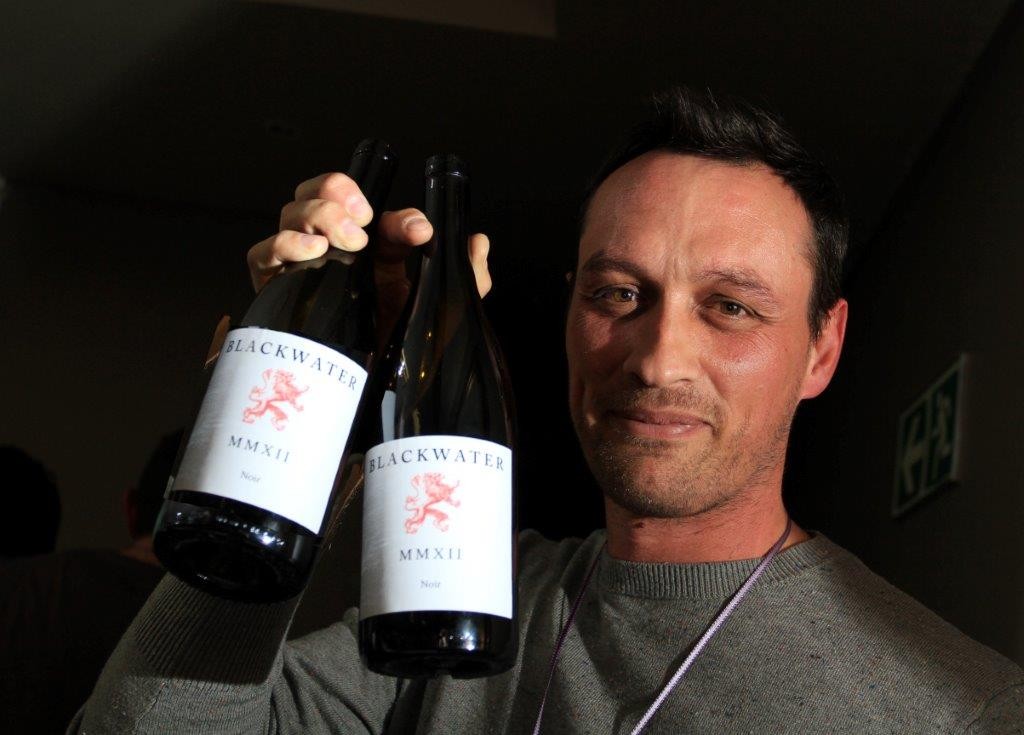
‘I was ecstatic to hear that we were harvesting at all. There were regions that didn’t harvest,’ says Swartland winemaker Francois Haasbroek
For the past 10 years he has been researching different cultivars, travelling to different regions with climates similar to South Africa’s dry regions. He visited Greece, Spain, southern Italy, Portugal, Tunisia, Morocco and islands in the Mediterranean, probing whether their cultivars could be South Africa’s wine region’s saving grace.
He has now planted more than 30 new varietals, selected from his global travels, that he is putting through trials to find the varietal that copes best with drought.
“For example, Grenache is much more drought-tolerant,” he says. “Merlot is the worst grape in the world when it comes to water.”
Sadie says Sauvignon Blanc, South Africa’s biggest-selling white wine, has the highest consumption of water for a white wine. “We can’t build a wine industry on a grape that is annihilating our water resources.”
Sadie says he is still bench-testing and can’t yet predict which grapes will eventually be South Africa’s saviour, because vines need to be at least a decade old to truly understand their character.
A red wine grape named Cinsaut, which has a rich history in South Africa with a number of old bushvines, is a drought-resistant variety with a big future in South Africa.
In Robertson, however, Jonker says he still sticking with the grape varietals that have bought him success for the past 100 years. “The threats are not at a level to influence our choice of varietals,” he says. “Over generations the same varietals that thrived here are still thriving.”
De Wet says Excelsior has had great success with Petit Verdot and he will expand the varietal in future. Like Sadie, he is excited about the future of Grenache.
But De Wet believes the big challenge will be to get the wine-drinking market to accept the new grape varietals: “Will people buy a strange-sounding varietal, which they can’t even pronounce?”
De Wet says ultimately the land is borrowed from the next generation, and with climate change on the horizon this generation of farmers carries a weight on their shoulders to make the right choices.
Sadie agrees: “I’m trying to leave a legacy for the generations to come, for South Africa’s wine future. And what we do now matters very much in the years to come.”
To see how climate change is affecting Southern Africa, use the Oxpeckers ClimaTracker app.
This investigation was funded by an Adaptation grant provided by the Earth Journalism Network

